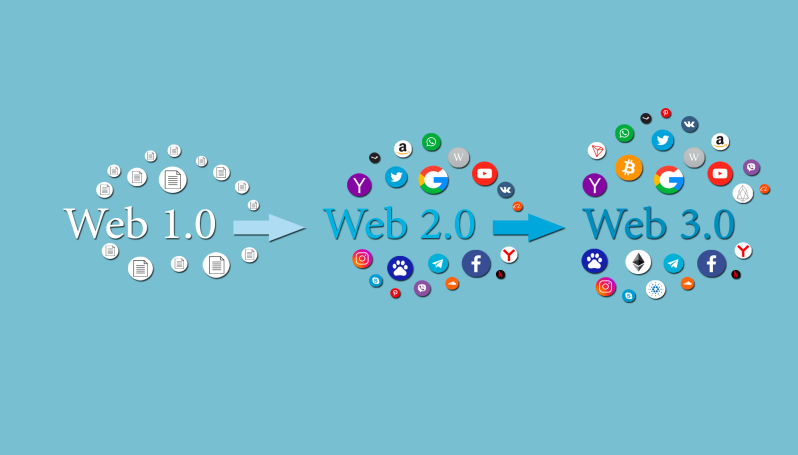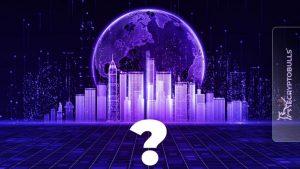Introduction
One of the most busy words in the internet world lately, what is Web 3.0? Internet technology has changed very rapidly in the past twenty years. With the developing internet technology, we have transitioned from the chat style that takes place in the form of mutual chat to advanced social media platforms. Digital payments that take place at the basic level have been replaced by digital payments made online. In the continuation of this development, we also experienced new internet-based technologies such as Crypto, NFT and Blockchain, which are very popular. In all this changing landscape, the Internet has become a vital element of human interaction, communication and being connected. We have seen Web 1.0 and Web 2.0 so far, but we do not have detailed information about Web 3.0 yet.
Let's take a closer look at Web 3.0.
History of the Internet

Web 1.0
The technology used in the early days of the Internet is called. Internet users in this period used the Internet only for information purposes. He goes to the website, reads the information and extracts it. Many activities did not have internet access as they do today. He did not even have a chance to comment on the information read on the Internet. In short, web 1.0 is a completely one-sided document-oriented technology that one party shares and the other party sees and reads.
As technology and living conditions changed, users needed more information on the internet. After this need, Web 2.0 emerged.
Web 2.0
Web 2.0 is generally used in social media, online music listening, personal websites, messaging applications, etc., which came into our lives more after 2003-2005. It is a human-oriented technology that focuses on human-human interaction. In Web 2.0, there is bilateral interaction and interactive.
Web 3.0
After the Web 2.0 revolution, Web 3.0 technology was developed to make sense of the contents transferred to the virtual world. The main purpose of the developing new technology is to create a web environment where the data transferred to the internet is configured to be read directly by computers.
Web 3.0 technology refers to the technology in which the control of the internet is out of the hands of humans, and the problems are interpreted with artificial intelligence methods or software solutions and the result is reached. In the developing web technology, solutions are getting smarter by using artificial intelligence. Therefore, this period can also be defined as the development of Semantic Web or Machine learning.
The Semantic Web is a development that allows machines to quickly understand and respond to complex human requests based on their meaning, performing tedious tasks such as discovering, collation, and presenting information found on the Web.
The semantic web allows the collected data to be collected and analyzed both by the user and collected and analyzed by artificial intelligence.
Web 3.0 has revolutionized the world of advertising and marketing and has led to the emergence of personalized content. For example, advertisements are presented according to the content found on the websites that the person browses. Thanks to advanced algorithms and database systems that communicate with each other, users can be informed about the place they previously visited, the place they shopped, the page they liked, etc., according to their preferences and interests. Suggestions, advertisements and similar results related to the criteria are displayed as personalized.
Structures such as suggestion systems used in web applications, face recognition feature and person tagging in photos uploaded with image processing technology, video intelligence, integrated assistant applications that work to provide users with a better user experience are shown as innovations of the Web 3.0 period.
If we want to give a similar example, the internet is completely customized according to your preferences and interests, for example, if you are constantly watching emotional videos on Tik Tokta or Instagram, if you pass violent videos quickly, that platform will categorize you as an emotional person and the next videos will come according to your interests and preferences. that is, the algorithm will bring you emotional videos.
With Web 3.0, hot wallets instead of bank applications, voice commands instead of typing in search engines, VR glasses, artificial intelligence, cryptocurrencies, decentralized finance etc. entered our lives in recent developments.
Although the concept of metaverse has been developed with little work in Web 3.0, Web 4.0 will be complete if the actual metaverse concept is implemented.
Web 3.0 Identifier Properties
- Ease of use: For example, users won't be able to register due to geo-restrictions. Authorization is not required as long as cryptography ensures that information is transferred in a protected manner.
- Security: Centralization: Limits network penetration to perform malicious activities.
- Clarity: Data recording processes are transparent, so every user can watch them. It recommends protocols for users to store their own data and share as little as possible.
- Wide adoption of artificial intelligence: With the use of this software, companies use users' preferences to fully meet their needs and expectations. AI technology offers users fast verification and accurate information.
- Virtual reality: Breaking the boundaries between the real and digital worlds through the use of 3D graphics and VR technologies. Metaverse, the first concept that comes to mind when talking about the future, combines seamlessly with the virtual universe and allows IoT devices to be added to the 3D designs of websites. Physical objects can be easily converted into digital objects.
- Ubiquity: Makes the Internet available to anyone, anywhere, anytime, and relies heavily on IoT sensors.
Blockchain, Cryptocurrency and Digital Crypto Wallets

Blockchain technology is used to create Web 3.0. Blockchain can be thought of as a distributed electronic ledger. Blockchains can provide a digital record without a central authority. Since it has a distributed network, it provides convenience by eliminating manual processing intensity and authentication.
Briefly, Blockchain is a distributed database system that provides encrypted transaction tracking. The determined blocks are encrypted, never modified and made unbreakable. Blocks are distributed to everyone on the entire network, and everyone has the same encrypted information.
Cryptocurrency is a virtual currency protected by cryptography. The fact that it is a virtual currency makes it impossible to copy or forge crypto money. Another advantage of cryptocurrencies is that they are not issued by a central bank or mint, that is, they are not under the control of states. The underlying technology of cryptocurrencies is Blockchain.
Digital Crypto Wallets, acting as a digital identity allowing anyone to transact, completely user-controlled wallet without registration with a central service provider It is a technology based on It is often possible to use the same wallet on more than one blockchain. In short, a cryptocurrency wallet is the tool that helps you interact with the blockchain network. There are different types of crypto wallets. The majority of crypto wallets are software-based, which makes software wallets easier to use than hardware wallets.
There is strong interplay between these three technologies as Web 3.0 networks will operate through decentralized protocols that are the building blocks of blockchain and cryptocurrency technology. They will be interoperable, successfully integrated, automated by smart contracts.
Security on the Web 3.0 Side
Web 3.0, which includes the formation and development of many new technologies such as blockchain, crypto money, smart contracts, smart systems and augmented virtual reality, is dragging its disadvantages as well as the advantages it brings.
In Web 3.0 and web 4.0 technology, which we are slowly getting into, almost every area of life will transition to the virtual universe. This technology, fully focused on virtualization and supported by augmented reality, will change the moral, legal and ethical concepts that are physically created. With the changing concepts, since we are likely to encounter security problems wherever there are people, even in the virtual environment, the security problems that we may encounter and the precautions that can be taken should be investigated by cyber security researchers.
We may face very serious security problems in data integrated in Web 3.0. Imagine logging into all your smart devices, personal data, user accounts and systems with just a saved password. Although the password is strong, if it is cracked by cybercriminals, all accounts and data in the system will be accessed with the same password. As a result of personal and biometric data breaches that will be recorded in large companies and systems that are transferred to the virtual universe, critical KVKK and Information Security problems will occur.
What about Web 4.0?

It is a technology that moves away from physical disks and is based entirely on virtual networks.
Web 4.0, where internet-based computing (cloud computing) applications stand out in the storage of personal files, data and content, in short, is to be able to do everything we can do on a computer on the internet. It is the transfer of real life to the virtual environment. We can say that the transition process to Web 4.0 has started gradually.
Let's see which feature of the developing web technology will surprise us in the near future.
[vc_row][vc_column][vc_cta h2=”” add_button=”bottom” btn_title=”Teklif Talep Edin” btn_style=”flat” btn_shape=”square” btn_color=”danger” css_animation=”fadeInLeft” btn_link=”url:https%3A%2F%2Fcyberartspro.com%2Fteklif-isteme-formu%2F||target:%20_blank|”]Siber Güvenlik, Dijital Dönüşüm, MSSP, Sızma Testi, KVKK, GDPR, ISO 27001, ISO 27701 ve DDO Bilgi ve İletişim Güvenliği Rehberi başlıklarıyla ilgili teklif almak için lütfen tıklayın.[/vc_cta][/vc_column][/vc_row]












